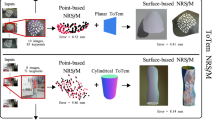Abstract
The Topological Active Volumes (TAV) model is a 3D deformable model based on the active nets and used for segmentation and reconstruction tasks. The model implements automatic procedures, the so called topological changes, that alter the mesh structure in order to segment complex surfaces, such as pronounced curvatures or holes, and detect several objects in the scene. This work analyses previous strategies for performing topological changes in the model and proposes a new methodology that overcomes the limitations of former strategies and improves the adjustment.
Preview
Unable to display preview. Download preview PDF.
Similar content being viewed by others
References
Kass, M., Witkin, A., Terzopoulos, D.: Active contour models. International Journal of Computer Vision 1(2), 321–323 (1988)
Terzopoulos, D., Witkin, A., Kass, M.: Constraints on deformable models: Recovering 3D shape and nonrigid motion. Artificial Intelligence 36(1), 91–123 (1988)
McInerney, T., Terzopoulos, D.: T-snakes: Topology adaptive snakes. Medical Image Analysis 4(2), 73–91 (2000)
Duan, Y., Qin, H.: A subdivision-based deformable model for surface reconstruction of unknown topology. Graph. Models 66(4), 181–202 (2004)
Lachaud, J.O., Montanvert, A.: Deformable meshes with automated topology changes for coarse-to-fine 3D surface extraction. Medical Image Analysis 3(2), 187–207 (1999)
Lachaud, J.O., Taton, B.: Deformable model with a complexity independent from image resolution. Comput. Vis. Image Underst. 99(3), 453–475 (2005)
Pons, J.P., Boissonnat, J.D.: Delaunay deformable models: Topology-adaptive meshes based on the restricted delaunay triangulation. In: IEEE Conference on Computer Vision and Pattern Recognition, Minneapolis, USA, pp. 1–8 (2007)
Barreira, N., Penedo, M.G.: Topological Active Volumes. EURASIP Journal on Applied Signal Processing 13(1), 1937–1947 (2005)
Tsumiyama, K., Yamamoto, K.: Active net: Active net model for region extraction. IPSJ SIG notes 89(96), 1–8 (1989)
Barreira, N., Penedo, M.G., Penas, M.: Local energy minimisations: An optimisation for the topological active volumes model. In: First International Conference on Computer Vision Theory and Applications, vol. 1, pp. 468–473 (2006)
Barreira, N., Penedo, M.G., Ortega, M., Rouco, J.: On the improvement of the topological active volumes model: A tetrahedral approach. In: Third International Conference on Computer Vision Theory and Applications, pp. 529–534 (2008)
Author information
Authors and Affiliations
Editor information
Rights and permissions
Copyright information
© 2008 Springer-Verlag Berlin Heidelberg
About this paper
Cite this paper
Barreira, N., Penedo, M.G., Alonso, C., Rouco, J. (2008). Handling Topological Changes in the Topological Active Volumes Model. In: Campilho, A., Kamel, M. (eds) Image Analysis and Recognition. ICIAR 2008. Lecture Notes in Computer Science, vol 5112. Springer, Berlin, Heidelberg. https://doi.org/10.1007/978-3-540-69812-8_12
Download citation
DOI: https://doi.org/10.1007/978-3-540-69812-8_12
Publisher Name: Springer, Berlin, Heidelberg
Print ISBN: 978-3-540-69811-1
Online ISBN: 978-3-540-69812-8
eBook Packages: Computer ScienceComputer Science (R0)




